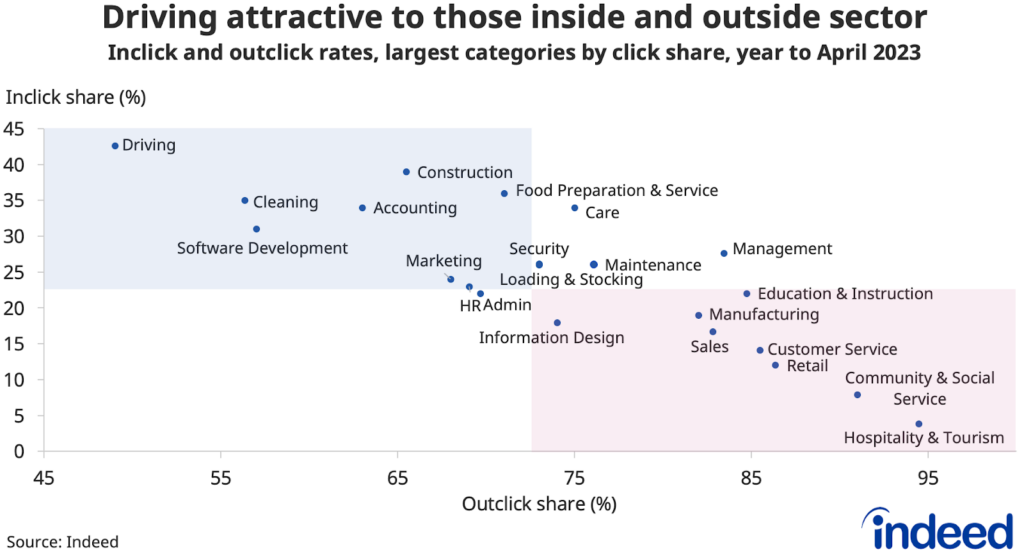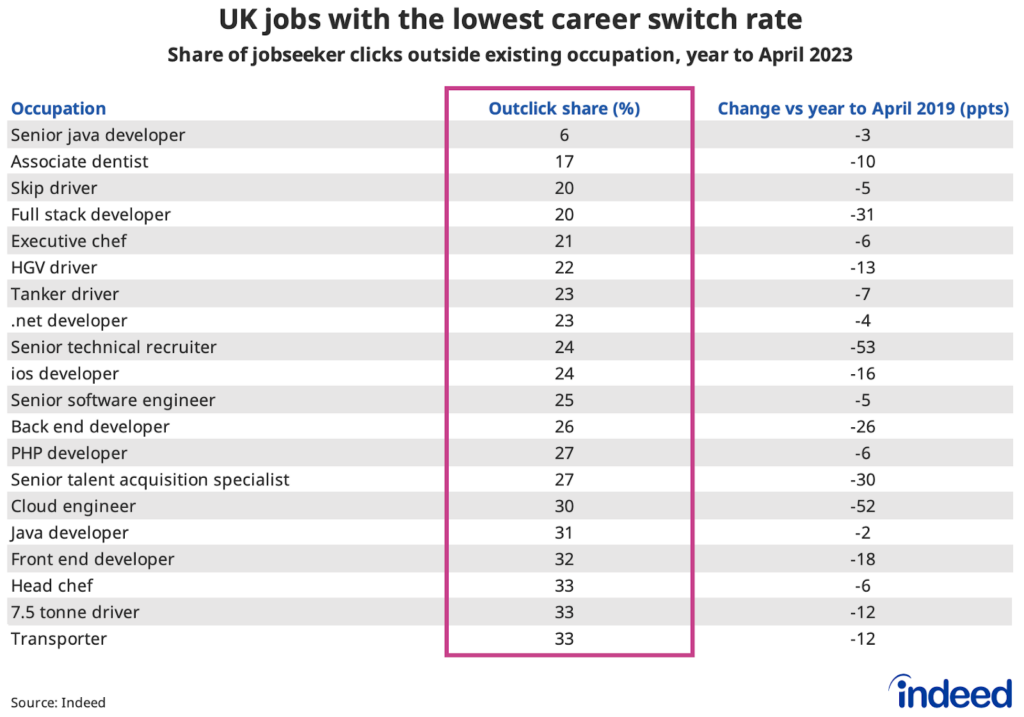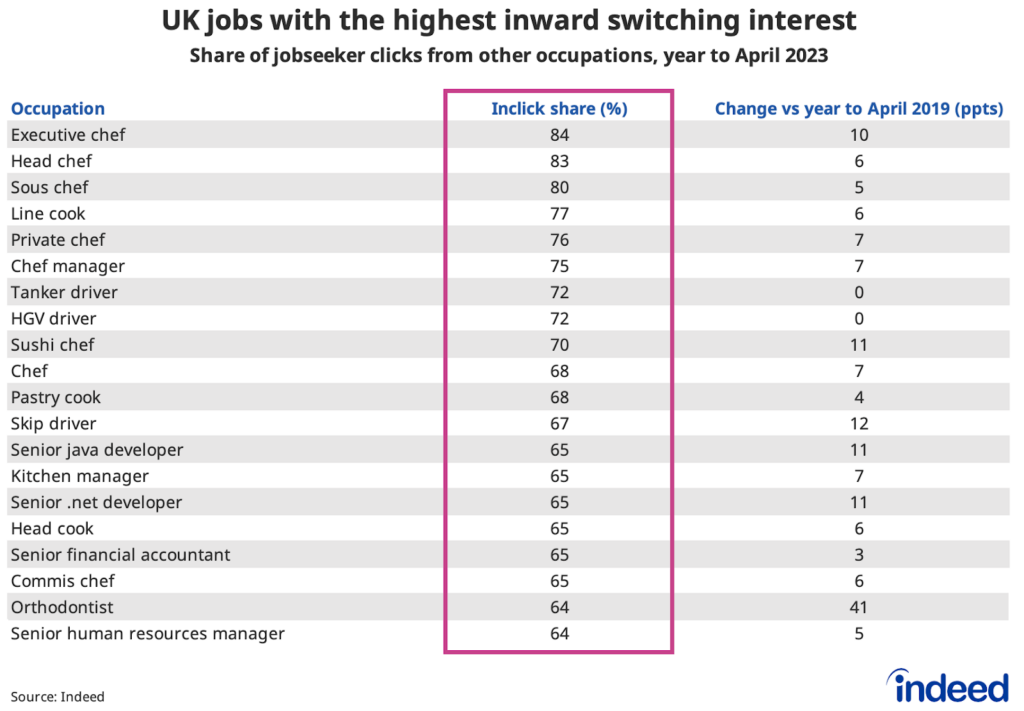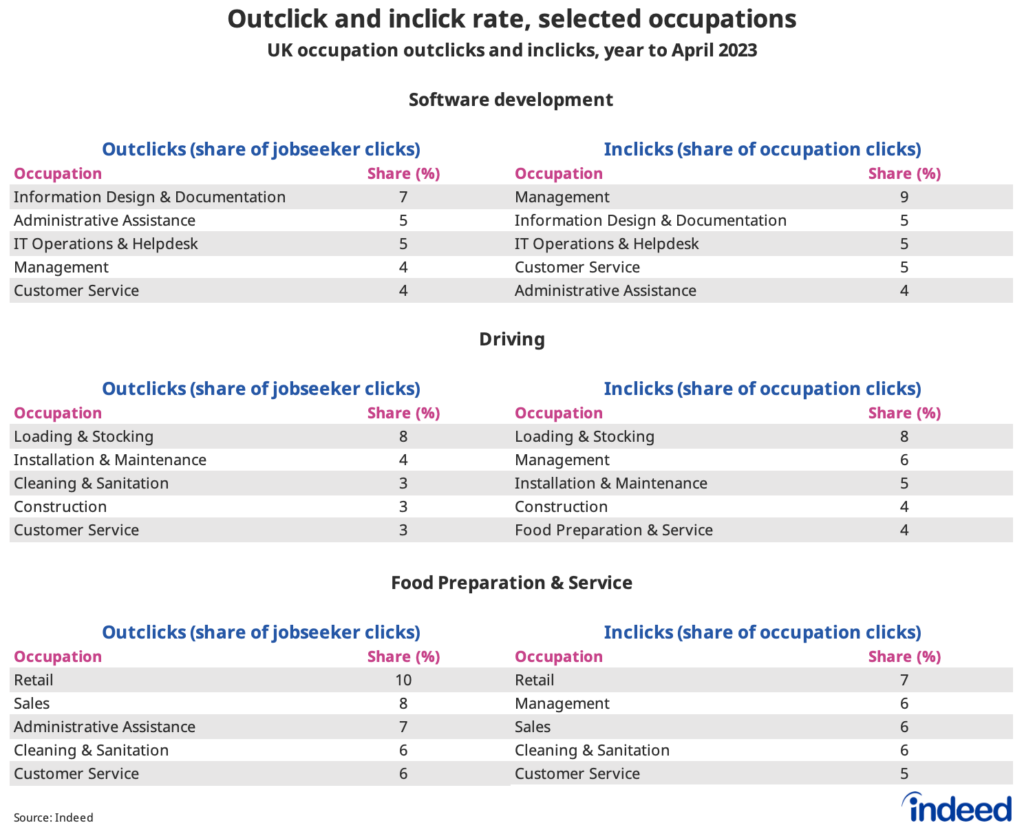Key points
- Indeed data shows that in the year to April 2023, driving had both the highest sector loyalty, and attracted the greatest interest from other professions. Software development, accounting, and cleaning & sanitation also fared well on both counts.
- Conversely, hospitality & tourism, community & social service, retail and customer service score poorly on both metrics.
- These patterns haven’t greatly changed since pre-pandemic, suggesting there hasn’t been a widespread re-evaluation among workers.
- The attractiveness of different occupations likely reflects varying combinations of pay, flexibility and barriers to entry. The ‘stickiest’ jobs tend to be specialised ones where workers have made a considerable investment gaining specific skills and experience.
- Jobs that are unattractive both to existing workers and career switchers tend to be less specialised entry-level roles, with lower pay and less favourable working conditions.
Many workers contemplate a career change at some point in their lives, for a variety of reasons both positive (higher pay, greater flexibility or career advancement), and less-positive (burnout, redundancy or ill health). But some jobs seem to inspire greater loyalty than others — or are simply more difficult to leave.
Tech and driving jobs appear popular both with those already in them, and those seeking a new opportunity. But it may be harder to attract and retain employees in retail, customer service and hospitality jobs, according to an analysis of user data and jobseeker CVs.
Using Indeed data on job clicks and linking them to jobseeker CVs, we can track how often a jobseeker explores opportunities outside their current profession. Searching outside your existing occupation doesn’t necessarily mean a person will switch careers, but it does indicate that a job seeker is at least open to the idea, or not completely satisfied, with their current job.
To measure occupational switching interest, we looked at the rate of jobseeker clicks outside their job category (outclicks), and the rate of clicks on a job from jobseekers in other categories (inclicks).
Inclick and outclick shares are fairly high across all categories. It appears that jobseekers frequently like to see what opportunities are out there, even if many don’t end up following through.
But there are some clear patterns in which occupations people appear most keen to leave, and which attract the most interest from elsewhere. Interestingly, these patterns haven’t greatly shifted since pre-pandemic, suggesting there hasn’t been a widespread re-evaluation of perceptions.

The top left part of the above chart can be thought of as the ‘sweet spot’ (from both an employer’s and jobseeker’s perspective) where inbound interest is high and few people are looking to leave. In the bottom right section, the reverse is true.
Most attractive occupations to outsiders, where few workers want to leave
Driving — While few drivers want to leave the profession, this category attracts lots of interest from other categories. Though sector switchers may need to gain training and licences for certain driving jobs, barriers to entry are not insurmountable for most. Despite long-standing concerns over working conditions for some driving jobs, such as HGV drivers, the category as a whole exhibits a low propensity to look at jobs in other occupations.
Acute driver shortages throughout the UK grabbed the headlines in 2021, and employers responded by ramping up pay to try and fill roles. Driving jobs saw particularly strong posted wage growth in late-2021 and early-2022. Though pay growth has eased since, the uplift in pay rates across the sector may have contributed to a decreased propensity to look outside the sector (driving is one of the few categories to have seen a sizeable fall on this metric since 2019).
Cleaning & sanitation — High inbound interest may partly reflect low barriers to entry. Hours may be relatively more flexible in cleaning jobs than some other similarly paid occupations, which may also be a factor behind low outbound interest, despite generally low pay.
Software development — Despite recent tech layoffs, the sector is renowned for high salaries and generous benefits, which are a clear pull factor. There are barriers to entry though, with workers needing to acquire substantial skills and training for such a career.
Accounting — Another high-paying occupation requiring considerable training, it attracts high inbound interest, and fairly few people are looking to leave the profession.
Construction — Inward interest is high, while outclick rates are lower than for most categories. Barriers to entry are variable, and specialised trades may require years of training.
Occupations that don’t attract much interest and people want to leave
Conversely, some occupations don’t have much sector loyalty and are also not attractive to career switchers. These include hospitality & tourism, community & social service, retail and customer service. All of these are relatively low-paid categories and aren’t renowned for particularly favourable working conditions, so it’s perhaps unsurprising that these don’t rank highly.
‘In the middle’ occupations
Some of these are office-based categories like marketing, human resources, administrative assistance and information design & documentation. Typical salaries might not be as attractive as in categories like software development or accounting, but there may well be some flexibility to work remotely.
Others are in-person occupations like security & public safety, loading & stocking and installation & maintenance. Though pay may not be especially high, working in these occupations is perceived more favourably than some of the alternatives.
Job titles with the lowest career switch rates
Looking at occupational categories only tells part of the story; delving into more granular job title data suggests that the degree of specialisation also plays a role in the propensity to explore career switches.
The job with the lowest outclick rate is senior java developer, while several other tech and software development roles also have particularly low outclick shares.
Specialised driving jobs also show low propensity to look outside the sector. Drivers of skip lorries, HGVs and fuel tankers have among the lowest outclick shares of all jobs.
A common factor appears to be a high degree of specialisation in terms of skills, training and experience for most of these roles. Given the considerable investment and sacrifices these workers may have made acquiring these, they may be particularly reluctant to consider leaving for another occupational category.

The job titles most attractive to career switchers
Cooking jobs are particularly attractive to people considering a career switch. Over half of the top twenty job titles with the highest interest from workers in other occupational categories are chef or cook roles. Some of that might be people with a passion for cooking who want to explore the possibility of doing so professionally. Three driving job titles also feature in the list, alongside accountancy and tech roles.

Where is the interest going to and from?
Focusing on three categories with lots of job titles that feature in the above analysis, and mapping the occupations where jobseekers are looking into and out from, we see some clear patterns.
For example, in software development, the highest shares of both inbound and outbound clicks are from adjacent tech categories like information design & documentation and IT operations & helpdesk. That’s unsurprising given the skills and experience held by these workers are more likely to overlap with the requirements of software developer jobs. However, management, customer service and administrative assistance also feature. Workers making career switches between these occupations may have a gap to bridge and need more in terms of training and support.
The pool of potential workers for driving jobs appears to particularly overlap with categories like loading & stocking, installation & maintenance and construction. For food preparation & service, it’s the retail, sales, cleaning & sanitation and customer service categories where there seems to be the most overlap.

Conclusion
In today’s tight labour market where skill and talent shortages are common, both attraction and retention of staff are key. Job switching rates vary considerably across occupations, and some face greater challenges than others.
Employers wanting to capitalise on sector switching interest need to be aware of where they can lure talent from, and then offer the right information, training and support to enable people to succeed in their new careers.
Those looking to boost retention need to be mindful of the sectors they are more likely to lose staff to, and consider what they can do to better meet the needs of their workforce.
Methodology
Jobseekers are allocated an occupational category based on the last job title in the CV they have uploaded on Indeed UK.
Jobseeker clicks are designated as an occupation outclick if they are on job titles in a different category from the last job on their CV. For example, if a HGV driver clicks on a posting for warehouse workers then that would be considered an outclick. However, if that same HGV driver clicks on a posting for a dumper driver then that isn’t an outclick.
An inclick, by comparison, refers to clicks into an occupation from a jobseeker whose current job sits in a different occupational category. For example, clicks on jobs in the food preparation category can come from jobseekers from a range of different occupational groups.



